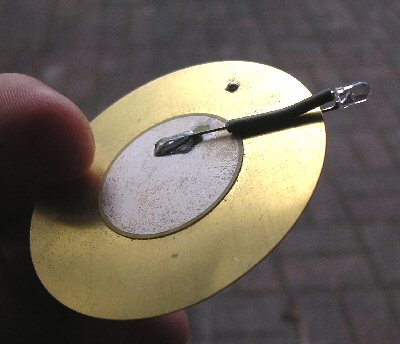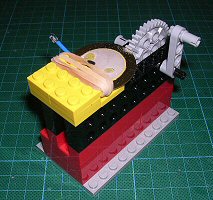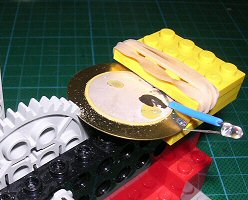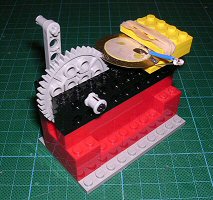link to 6 homemade electrical generator page
A simple demonstration of piezoelectricity
by Dr Jonathan Hare - The Creative Science Centre, Sussex University
(taken from: Simple demonstration of Piezoelectricity. J. P. Hare, IOP press, Journal of Physics Education, May 2006, vol. 41, p.212-213)

Photo of the simple apparatus to demonstrate piezoelectricity. An LED is wired to a piezoelectric transducer.
The LED briefly lights when the device is flicked - neatly demonstrating that electricity has been generated by stress and strain.
Introduction
Piezoelectricity, is an effect that occurs when mechanical stress is applied to certain materials. An electrical polarisation is set up in the crystal with the result that the faces become electrically charged. The charge reverses if the compression changes to tension. Because the effect is reversible an electric field applied across the material causes it to contract, or expand, according to the sign of the field. Piezoelectric materials include; Quartz crystals, Rochelle salts, barium titanate [1].
Everyone is familiar with the high pitched “beep-beep” of a car alarm re-setting itself, a wrist watch alarm or the sound of a smoke detector. The sound is made by a piezoelectric transducer. An alternating electric voltage is applied to a thin slab of piezoelectric material which flexes at the same rate. The device is only efficient around a narrow band of frequencies but at this resonance it works so effectively that a very loud noise is produced for very little power and size – hence their use as a sounder in many electrical devices.
Piezoelectric crystals are used in cigarette and gas stove lighters, where tension produced by a lever produces 100's of volts - enough to create a spark to light the gas. We can also use this effect to show piezoelectricity in a safe and more straightforward way.
How to make the demonstration
The piezo-transducer consists of a thin slab of piezoelectric material sandwiched between two flexible metallic connections (usually a thin piece of flexible brass sheet metal and on top a thin gold layer). Obtain a piezo-transducer, as large as you can (perhaps salvaged from an old toy or purchased from an electronic supplier [3]). Connect an LED between the two transducer connections (see picture above).
Hold the transducer (with attached LED) in one hand between thumb and forefinger to one side. Use a finger on the other hand to flick the opposite side of the disc. The flexing creates stress in the piezoelectric material which produce a corresponding voltage, enough to briefly light the LED – neatly demonstrating piezoelectricity!
Note: a neon indicator can sometimes work in this simple demonstration as the voltages produced by the piezo crystal can be 100V [2]. The current is very low so it does not represent a health hazard.
References and Notes
[1] The Penguin Dictionary of Electronics, E. C. Young, any edition
[2] The Forrest Mims Circuit Scrapbook, Vol. II, LLH Tech. Pub, 2000
[3] Maplin Electronics codes: piezo-transducer: YU82D, super bright LED: UF72P the two should be less than a pound.
[4] Mike Bullivant, the Chemist in the Zanzibar (5th) series of the Rough Science TV series made piezoelectric Rochelle salts. This was used as the microphone element for a hydrophone to listen to marine life underwater. For those interested in the details of the chemistry of making your own piezo-crystals these are to be presented in a forthcoming article by M Bullivant and J Hare in the RSC journal, Education in Chemistry.



Photo of a very simple hand-cranked Lego demonstration piezo device. The crank is attached to a Lego cog, as it goes around each cog tooth flicks the piezo element - flashing the LED. The vibrations seems to brake the solder joint to the top of the transducer so I used a rubber band and some lego parts to hold the top LED connection in place. (Note: the transducers seem to come in two thicknesses of brass sheet metal, the thin version will work best with this very simple device).
link to 6 homemade electrical generator page
Dr Jonathan Hare, E-mail: jphcreativescience@gmail.com
NOTE: Although none of the experiments shown in this site represent a great hazard, neither the Creative Science Centre,
Jonathan Hare nor The University of Sussex can take responsiblity for your own experiments based on these web pages.
THE CREATIVE SCIENCE CENTRE
home | diary | whats on | CSC summary | latest news



